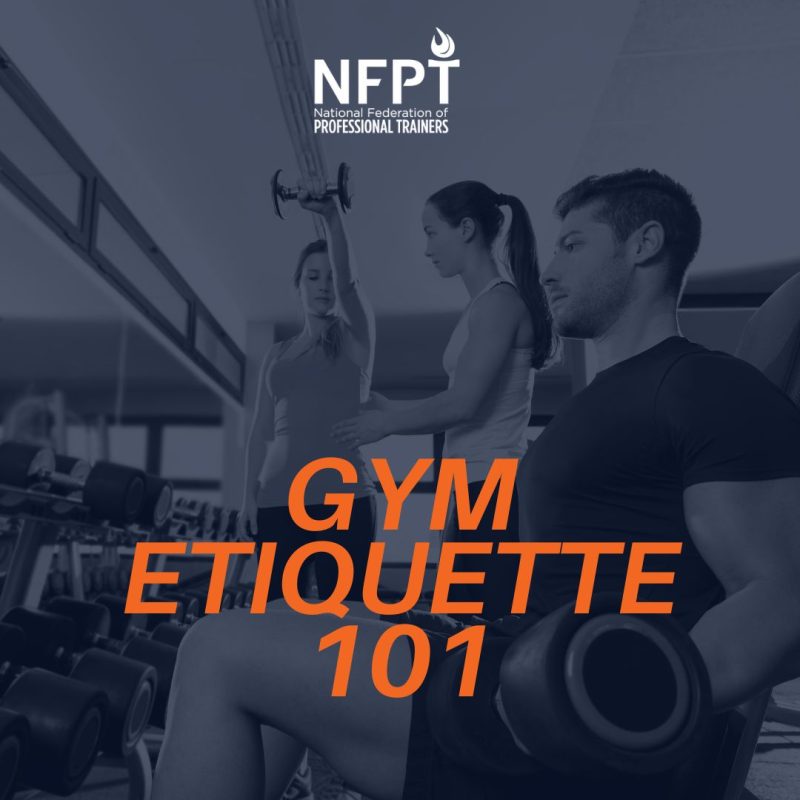
Gym etiquette plays an important role in any gym, and personal trainers have an obligation to relay certain concepts to our newest clients. Adhering to an etiquette is what makes someone “fit in” or, at least, look or feel like they know what they’re doing and understand how to respect others in the same forum.
Whether we train our clients in a gym, in their home, or even outdoors, we can help them understand and grasp the etiquette for the times they may exercise in a gym or some type of communal exercise setting. Even if they aren’t a member of a gym while you’re working with them, chances are they will eventually find themselves in a situation where such etiquette will come in handy. If they’re comfortable knowing what to do and what not to do, they’re more apt to continue working out in the gym.
While most rules of gym etiquette are pretty basic, they aren’t always obvious to many gym-goers, especially newbies. Some of the rules are written and displayed in gyms (like no spitting, no cameras, etc.), while some are unwritten rules, we all just need to know. I surveyed people across the country and a few overseas to find out the top 15 complaints at a gym. I call them #gymfails. Most likely you have seen some of these complaints in action or may have even committed one or two of these gym transgressions:
- Not wiping down equipment (this was the biggest complaint by a landslide)
- Lifting and caveman-type grunting
- Not re-racking weights
- Talking on the phone while using equipment
- Watching other people exercise
- Leaving wet towels in the locker room/sauna
- Walking into classes late
- People talking to you while exercising
- Provocative dressing
- Hogging equipment
- Cocky strutting
- People who stink
- Those trying to find a “hook-up”
- Germs brought into the gym
- Slamming weights down to get noticed
Let’s break down the most basic and preventable complaints and advise our fitness clients accordingly.
Keeping Germs at Bay
Wipe down equipment before and after use. Most gyms provide sanitizing spray, disposable towels, and/or wipes. Use them to protect yourself before using equipment. Protect others by wiping them down after workouts. Even if you’re not ill, no one wants to come in contact with your sweat.
If you’re sick, stay home. Perhaps the most etiquette-y rule in gym etiquette. Get better before returning to the gym with spreadable germs that could infect others. There’s no reason to push the immune system either, so wait and heal at home. The gym can wait. Even if you’re not sick, avoid touching your eyes, nose, and mouth while in the gym. This will prevent you from infecting yourself with whatever is out there or spreading your own germs around.
Consider wearing exercise gloves. Gloves can help with gripping weights, kettlebells and bars. They help ward off calluses too. Plus, wearing a pair of gloves offers an extra layer of protection between your skin and the germs that might be floating around. The gloves also serve as a reminder to not touch your face.
Wash your hands. It’s good hygiene and a big defense in the war on germs.
Bring your own supplies when applicable or possible. This might include mats, straps, gloves, etc.
Keep sweat confined to the sweat-er. Perspiring is our body’s built-in cooling mechanism and for many, breaking a sweat is an end-goal during exercise (though definitely not an indication of fitness or even a good workout!). It keeps our temperature in check working on an automatic internal thermostat. While we all have sweat glands and pores for releasing sweat, some people sweat more than others.
Whether it’s a little or a lot, sweat shouldn’t be passed on to others. Caution clients to be aware of any sweat that drips on equipment or on the floor; it needs to be wiped up. Also, to prevent sweat from slinging on others, it’s helpful to keep long hair tied back in some way. Bring a towel from home to wipe up dripping sweat. “Super sweat-ers” might consider the old-school sweat wristbands and headbands to absorb sweat. They work!
Aside from keeping things sanitary for ourselves and others, there are some other ways to be considerate in the gym world.
Be Mindful of Others
Be mindful that you are not at home and should not be using your device as if you are. If you’re going to take a phone call, engage in a texting conversation, or check the latest social media posts on your phone, don’t use the bench or exercise machines as a seat. Take it outside and let others use the equipment for exercising. Or better yet, put your phone on airplane mode while in the gym to minimize distractions.
When taking selfies or recording your next PR, be considerate of others. Don’t block their workouts or be loud and distracting for your own benefit.
Read body language (which in a gym setting may include simply wearing headphones!) before striking up a lengthy conversation, or any conversation. Many gym rats don’t like to be interrupted during their workouts.
Maintain your space and distance between others. It’s impolite and against gym etiquette to stand and stare at someone while waiting for a piece of equipment to become available. Go find something else to do until the machine/equipment is available. It goes without saying, never ever touch someone without permission (unless, of course, they are having a physical emergency)
Dress Appropriately
While your attire decisions don’t always fall under gym etiquette rules wearing the right workout clothing really should have little to do with making a fashion statement and everything to do with purpose. Although looking good is important too, here are some things to consider with the functional part of clothing:
- Wicking fabric helps keep sweat off the skin and dries quickly.
- Baggy clothes can get caught on equipment. It’s also hard to monitor or correct form if the clothes are too big.
- Jewelry can be easily broken and might get caught on equipment. Wear jewelry sparingly, if at all, including engagement rings. (Consider silicone wedding bands* if you want to convey your status)
Wearing anything other than workout shoes has the potential for injury. High heels (yes, I’ve seen it), boots, and dress shoes are not going to be safe for exercise. Many facilities have rules against going barefoot in the gym, so inquire before unshodding. There are benefits and risks to training barefoot in this setting; use extreme caution.
If in doubt, it is best to do your research and locate a gym that aligns with your particular training preferences. That way you can be confident that when you turn up, you are bringing the right clothing and accessories with you to adhere to on-site policies.
Re-rack Weights
Encourage clients to return equipment to where they got it. Re-rack weights and hang any mats used. Return the balance balls, kettlebells, med balls, bands…all of it. First, it’s common courtesy but also helps keep the gym floor clear of items lying around where others might trip on them. Putting things back where they belong keeps the weights and equipment organized for others to use.
Curb the Noise
Dropping weights for attention is annoying. Sometimes, it’s necessary and sometimes, it just happens. Discourage clients from doing it as a way to get noticed.
Grunt if you must, but not as a means to be heard. Sure, we have loud exhales, an occasional gasp, and a grunt at times. But showing off with explosive grunts will only single the grunter out as a grunter. No bragging rights with that, but perhaps plenty of eye-rolls.
Don’t play music out loud. Headphones/earbuds are a must. We all have personal preferences and music tastes. Although some gyms play music, no one wants to have someone else’s music blaring during their workouts.
Refresher Course
Exercise junkies who frequent gyms probably know most of the gym etiquette rules. But, it’s easy to slip up and forget to wipe down equipment, return equipment, etc. Maybe a little refresher read is all that’s needed.
Or, maybe a client knows nothing about how to act in a gym. Why is it important for our clients to follow gym etiquette?
Ultimately, our training teaches clients ways to exercise and how to be fit. We teach them proper form, how to vary workouts using different muscle groups, how to use cardio, strength training techniques, functional ways to work out, mobility, and stretching. The list goes on.
With our guidance, and in a perfect world, our clients adopt a healthy lifestyle to carry them through the rest of their lives. Having a gym to go to and a place to fit in can keep them on track when they aren’t working with a trainer. Our efforts as trainers to show them how to get along in the gym rat world and applying proper gym etiquette might just be what sustains them for years ahead.
#gymetiquette101 #gymetiquette201 (soon to come)
Read Gym Etiquette 101* for all the ins and outs!
*affiliate link







